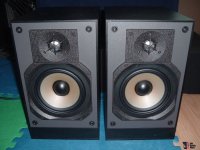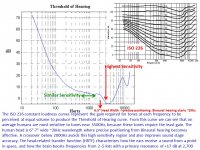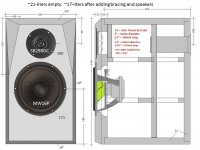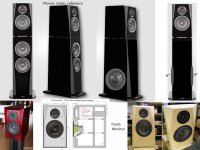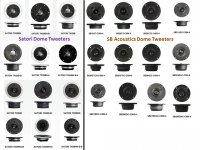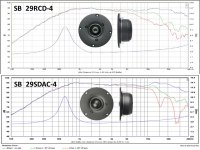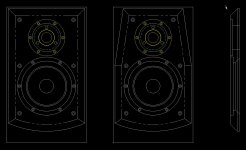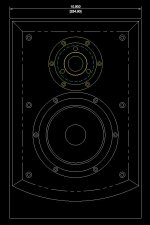I have listened to a speaker with the little cheap 4" from SB and a very old D28 tweeter and some 8" bass. It works great when filtered through a DSP and paying way more, might not give so much more. If you have experience and know how joggle with active filters, then many drivers will sound great, even cheaper ones.
I would follow Linesource' advice and invest in a DSP, rather than expensive drivers - if the budget is limited. I've heard grotesquely expensive drivers used wrongly and I will always prefer less expensive drivers used well, then the other way around.
Yes - some more expensive drivers can perform better in certain cases - if you know what to go by and how to deal with all the up's and downs in the compromise that all speakers in some sense are.
I would follow Linesource' advice and invest in a DSP, rather than expensive drivers - if the budget is limited. I've heard grotesquely expensive drivers used wrongly and I will always prefer less expensive drivers used well, then the other way around.
Yes - some more expensive drivers can perform better in certain cases - if you know what to go by and how to deal with all the up's and downs in the compromise that all speakers in some sense are.
Hi,
Yes a dsp can do many things other than pure filtering duties...
All that to say dsp filter is quite flexible and it can open ways you haven't thought about...
Thank you Krivium for bringing these ideas forward and making me think outside the norm. I can see I'll have all kinds of fun (hopefully fun and not frustration!) experimenting with the DSP.
One 'reference' for this speaker project is the old Paradigm Studio 20 V1 pair I am currently using. These are ported with a similar size midwoofer. Interestingly, the crossover is quite low at 1.5kHz. The protruding driver frames in the front baffle must cause diffraction issues. If I recall correctly the manual recommended always using the front grille which presumably addressed these.
The drivers are kevlar but the centre dust cap is made from a very soft, lossy material. Perhaps this was needed to address unwanted resonances or tone down a prominent midrange. Just guessing... Anyways to me the speakers have a slightly mellow midrange sound and at the time were noted for delivering nice sounding female vocals and the like. On the downside, they were also noted for having a bit of a bass hump. One of the midwoofers has developed a buzz audible when playing solo bass only (or testing with a signal generator) so I'll look into that when the new pair is up and running.
Apologies for getting OT...
Attachments
I have listened to a speaker with the little cheap 4" from SB and a very old D28 tweeter and some 8" bass. It works great when filtered through a DSP and paying way more, might not give so much more. If you have experience and know how joggle with active filters, then many drivers will sound great, even cheaper ones.
I would follow Linesource' advice and invest in a DSP, rather than expensive drivers - if the budget is limited. I've heard grotesquely expensive drivers used wrongly and I will always prefer less expensive drivers used well, then the other way around.
Yes - some more expensive drivers can perform better in certain cases - if you know what to go by and how to deal with all the up's and downs in the compromise that all speakers in some sense are.
There are certainly diminishing returns with the pursuit of perfection.
I have a lot to learn on this. (The more you know the more you know you don't know.). Hopefully I learn enough and I am persistent enough to properly execute a good active speaker design.
I have other relatively simple speaker projects on the go to help a bit with technique. So with this approach and the use of a flexible DSP and the backup plan I figure I can go with good drivers this time around.
Attached one slide on hearing sensitivity measurements which provides data supporting a 1700Hz crossover for MW16P and SB29RDC for your first MiniDSP design effort. A midwoofer covering 80Hz -1700Hz is a good choice for coherent Vocal Range reproduction. Kairos & Kalasan use a crossover ~1650-1750Hz.
=======
You could show your family a few different cabinet options. If you wife read Flatland, "A Romance of Many Dimenstions" you may be cutting BIG ROUNDs in a few days. Pictures by Picasso support artistic Avalon beveled cabinets, and a discussion of woofer box options below the Monitor cabinet says you are planning a future together.
===========
Adapting Troels Illuminator Monitor cabinet.
Illuminator-Monitor
~21-liters empty.
~17-liters after adding bracing and speakers and crossover.
Absorption material on all walls: fiberglass or polyfill or wool batts
========
Satori MW16P-4 speaker
-F3 = 42Hz Flared Port exit
2” = 52mm inside diameter
6.5” = 166mm long
---
2.5” = 63mm inside diameter
10.6” = 270mm long
---
–F3= 60Hz with Sealed Port
Qtc = 0.57 min over/under shoot
=======
You could show your family a few different cabinet options. If you wife read Flatland, "A Romance of Many Dimenstions" you may be cutting BIG ROUNDs in a few days. Pictures by Picasso support artistic Avalon beveled cabinets, and a discussion of woofer box options below the Monitor cabinet says you are planning a future together.
===========
Adapting Troels Illuminator Monitor cabinet.
Illuminator-Monitor
~21-liters empty.
~17-liters after adding bracing and speakers and crossover.
Absorption material on all walls: fiberglass or polyfill or wool batts
========
Satori MW16P-4 speaker
-F3 = 42Hz Flared Port exit
2” = 52mm inside diameter
6.5” = 166mm long
---
2.5” = 63mm inside diameter
10.6” = 270mm long
---
–F3= 60Hz with Sealed Port
Qtc = 0.57 min over/under shoot
Attachments
You could show your family a few different cabinet options. If you wife read Flatland, "A Romance of Many Dimenstions" you may be cutting BIG ROUNDs in a few days. Pictures by Picasso support artistic Avalon beveled cabinets, and a discussion of woofer box options below the Monitor cabinet says you are planning a future together.
LOL. Please also send my wife a financial justification for my project.
Attached one slide on hearing sensitivity measurements which provides data supporting a 1700Hz crossover for MW16P and SB29RDC for your first MiniDSP design effort. A midwoofer covering 80Hz -1700Hz is a good choice for coherent Vocal Range reproduction. Kairos & Kalasan use a crossover ~1650-1750Hz.
Interesting that setting the crossover in this region ensures the near point-source driver (tweeter) handles all the frequencies localized this way.
Adapting Troels Illuminator Monitor cabinet.
Illuminator-Monitor
~21-liters empty.
~17-liters after adding bracing and speakers and crossover.
Absorption material on all walls: fiberglass or polyfill or wool batts
========
Satori MW16P-4 speaker
-F3 = 42Hz Flared Port exit
2” = 52mm inside diameter
6.5” = 166mm long
---
2.5” = 63mm inside diameter
10.6” = 270mm long
---
–F3= 60Hz with Sealed Port
Qtc = 0.57 min over/under shoot
Thanks for the adaptation graphics! This is close to what I was modelling for the LF alignment but with the wrinkle of a highly damped closed box option.
LineSource: Fun comments !
I agree with the low cross-over point. I think that MW16P-4 should be crossed at no higher than around 2000. I currently cross mine at 1900 Hz (Samuel Harsch topology).
I have a slight memory that stadard SB29 does not like a low crossoverpoint with low order slopes. I dont think it is the best match IF you want to try low order slopes.
I dont know how different the MW19-4 is compared to the MW16-P. If used in a closed box, the MW19P-4 does not require a big box. I think it "kicks" more. That said MW16-P plays very very good. They require about the same crossover point.
I also totally agree with Digitalthor that expensive drivers are not always worth it. That said, I think the Satori drivers are very good value.
One thing to never forget is that a 6" driver will never play bass like an 8" inch driver.
Another opting is the SB26ADC-C000-4. (The Alu dome) For instance look at Troels Gravesens measurements.
I agree with the low cross-over point. I think that MW16P-4 should be crossed at no higher than around 2000. I currently cross mine at 1900 Hz (Samuel Harsch topology).
I have a slight memory that stadard SB29 does not like a low crossoverpoint with low order slopes. I dont think it is the best match IF you want to try low order slopes.
I dont know how different the MW19-4 is compared to the MW16-P. If used in a closed box, the MW19P-4 does not require a big box. I think it "kicks" more. That said MW16-P plays very very good. They require about the same crossover point.
I also totally agree with Digitalthor that expensive drivers are not always worth it. That said, I think the Satori drivers are very good value.
One thing to never forget is that a 6" driver will never play bass like an 8" inch driver.
Another opting is the SB26ADC-C000-4. (The Alu dome) For instance look at Troels Gravesens measurements.
LineSource: Fun comments !
I agree with the low cross-over point. I think that MW16P-4 should be crossed at no higher than around 2000. I currently cross mine at 1900 Hz (Samuel Harsch topology).
I have a slight memory that stadard SB29 does not like a low crossoverpoint with low order slopes. I dont think it is the best match IF you want to try low order slopes.
I dont know how different the MW19-4 is compared to the MW16-P. If used in a closed box, the MW19P-4 does not require a big box. I think it "kicks" more. That said MW16-P plays very very good. They require about the same crossover point.
I also totally agree with Digitalthor that expensive drivers are not always worth it. That said, I think the Satori drivers are very good value.
One thing to never forget is that a 6" driver will never play bass like an 8" inch driver.
Another opting is the SB26ADC-C000-4. (The Alu dome) For instance look at Troels Gravesens measurements.
Indeed. Bigger drivers have a better way of coupling to the air, which in return produce more potent sound the lower in frequency you go.
I still have not heard many tweeters that like to be crossed at 1700hz without sounding strained - but Satori may be the first one - I did not try - I always go for a smaller midrange to have a better power response and ligther cone - more crisp/clean upper midrange.
...I have a slight memory that standard SB29 does not like a low crossoverpoint with low order slopes. I dont think it is the best match IF you want to try low order slopes....
Another opting is the SB26ADC-C000-4. (The Alu dome) For instance look at Troels Gravesens measurements.
I think there is a trend here. For data I have found, simple domes generally have lower distortion than the ring domes where excursions are large and especially approaching the resonant frequency. If I'm visualizing it correctly, it concerns me that there is a relatively high ratio of radiated sound produced by material that is in more complex and less linear flexure in ring domes. As excursions increase, this gets worse - hence the increase in non-linear distortion at lower frequencies.
So to work well with a low crossover frequency, why not a dome tweeter? Why not a SB29SDAC instead of a SB29RDC or a TW29D instead of a TW29R???
SB Acoustics advertises 24 dome tweeters.So to work well with a low crossover frequency, why not a dome tweeter? Why not a SB29SDAC instead of a SB29RDC or a TW29D instead of a TW29R???
It seems to me that.....
-Hearing Sensitivity data favors crossovers under 2kHz for simple Mid-tweet integration.
-With popular modest slope LR2/LR2 passive crossovers, a robust tweeter becomes a good choice for a midwoofer.
It is well known that common soft-dome tweeter diaphragms do not move pistonic all the way up to 20 kHz. Due to mass and flexibility only the diaphragm close to the voice coil will generate sound up to 20kHz, hence there are break-up issues and some parts of the dome may move in opposite directions depending on frequency. Genius engineers designed dimpled soft domes for robust Fs=550Hz with smooth 16kHz-20Khz,
-- The SPL data for the dimpled SB29RDC looks smoother than for the SB29SDAC.
Attachments
...It seems to me that.....
-Hearing Sensitivity data favors crossovers under 2kHz for simple Mid-tweet integration.
-With popular modest slope LR2/LR2 passive crossovers, a robust tweeter becomes a good choice for a midwoofer.
Makes sense.
It is well known that common soft-dome tweeter diaphragms do not move pistonic all the way up to 20 kHz. Due to mass and flexibility only the diaphragm close to the voice coil will generate sound up to 20kHz, hence there are break-up issues and some parts of the dome may move in opposite directions depending on frequency. Genius engineers designed dimpled soft domes for robust Fs=550Hz with smooth 16kHz-20Khz,
-- The SPL data for the dimpled SB29RDC looks smoother than for the SB29SDAC.
Tradeoffs! In this case, better tweeter performance at the low end of its range vs the higher end. Off-axis response also seems to vary between the dome and ring-dome. Then I suppose there are characteristics that vary with diameter and other differences in construction such as radiator material to further complicate the decision. This makes the choice for a DIY build one of personal priorities, the design and/or the listening room. The genie is out of the bottle. Blissful ignorance is gone. Ack!
It would be nice to see what happens at higher SPL's so that it would be more evident how low a tweeter can be crossed before distorting.
To my ears a tweeter sounds strained when crossed below 2Khz. But does anyone have some clear sets of data to show how low a tweeter can be crossed with respect to optimum performance?
To my ears a tweeter sounds strained when crossed below 2Khz. But does anyone have some clear sets of data to show how low a tweeter can be crossed with respect to optimum performance?
It would be nice to see what happens at higher SPL's so that it would be more evident how low a tweeter can be crossed before distorting.
To my ears a tweeter sounds strained when crossed below 2Khz. But does anyone have some clear sets of data to show how low a tweeter can be crossed with respect to optimum performance?
Good question. If the harmonic distortion test results at hificompass can be used as one of the measures, then comparing the distortion levels at multiple input power levels should tell us something.
Compare the charts at 2.83V input and 5.60V input for these:
SB29RDC
SB Acoustics SB29RDC-C000-4 | HiFiCompass
Odd order distortion rises a lot below about 2kHz.
TW29R
Satori TW29R | HiFiCompass
Odd order distortion doesn't change nearly as much below 2kHz.
SB29SDAC
SB Acoustics SB29SDAC-C000-4 | HiFiCompass
Odd order distortion rises significantly below about 1.5kHz and there is some 5th harmonic weirdness around 1kHz.
This suggests to me that the TW29R might show less "strain" at higher SPLs when crossed low.
Last edited:
One should really add the SB26ADC to the comparisons as it appears to
out perform the TW29R.
It does look good. Just when I thought I had it narrowed down.
Does this tweeter have such low distortion at the low end because of its large linear travel (1.2mm)?
And in case you prefer fabric domes over aluminum, take a look at the SB26STAC-C000-4 as well.
I think I have decided on the Satori TW29R-B to go with the MW16P for this project for several reasons:
I can see a smallish TMM or MTM as a project in future that the SB26ADC looks well suited for.
I tried a layout that takes a bit of a design idea from Troels Gravesen's Illuminator Monitor suggested by Linesource. I may just stick with the original layout.
- It is what the kits this is most similar to normally call for
- It does have objectively better performance than the SB29RDC
- I already have an aluminum dome tweeter in my current main stereo pair and would like to try something different for this replacement
- It is time to get past the analysis paralysis.
I can see a smallish TMM or MTM as a project in future that the SB26ADC looks well suited for.
I tried a layout that takes a bit of a design idea from Troels Gravesen's Illuminator Monitor suggested by Linesource. I may just stick with the original layout.
Attachments
TW29R-4 tweeter.... you can swap the lower cost SB29RDC-4 tweeter with little sonic difference. Measurements from serveral websites prove this.
As someone who’s owned the TW29RN-B’s and the SB29’s I don’t agree with this statement. The TW29RN’s were much better and it was very noticeable. I’ve noticed that timbre and other characteristics don’t seem to translate through THD/freq graphs sometimes.
USA buyers can save $180 between a pair of SB29RDC vs. TW29R tweeters.With a limited budget, many will spend the extra 2* $70 difference for Satori midranges, or for MiniDSP over passive crossovers.
Madisound has a sale on the SB23RDC-4 tweeter for $32. Satori TW29R-4 is still $122.
-- MiniDSP?
-- Two 8" woofers SB23NRXS45-8?
-- One 12" SB34NRX75-6 (great sealed box woofer)?
-- Organic Produce for the Family?
The 10" width of the Illuminator Monitor cabinet helps reduce edge diffraction to ~1.3kHz, and also allows a matching width bottom woofer cabinet with two 8" woofers as shown in earlier pictures.
USA buyers can save $180 between a pair of SB29RDC vs. TW29R tweeters.
Madisound has a sale on the SB23RDC-4 tweeter for $32. Satori TW29R-4 is still $122.
-- MiniDSP?
-- Two 8" woofers SB23NRXS45-8?
-- One 12" SB34NRX75-6 (great sealed box woofer)?
-- Organic Produce for the Family?
The 10" width of the Illuminator Monitor cabinet helps reduce edge diffraction to ~1.3kHz, and also allows a matching width bottom woofer cabinet with two 8" woofers as shown in earlier pictures.
Using current conversions, the equivalent US prices in Canada are:
SB29RDC - $48.82USD.
TW29R - $129.76USD.
MW16P - $170.37USD.
So going to the SB29RDC from the TW29R frees up $161.88USD to spend on organic produce or even better, 108.644 bags of 1%BF milk from Shoppers Drug Mart.
At this point, I can easily change the baffle width to anything desired. As drawn, the cabinet width is currently 8-7/8" (225mm). Here it is with 10" width.
Attachments
- Status
- This old topic is closed. If you want to reopen this topic, contact a moderator using the "Report Post" button.
- Home
- Loudspeakers
- Multi-Way
- MW16P-4 vs MW16P-8 & TW29R vs SB29RDC-C000-4
